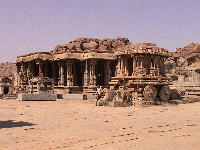| Hospet/ Hampi (April 6, - April 9, 2002) | ||
| Home Introduction Japan China Singapore Malaysia Indonesia New Zealand Australia Bali Thailand India Mumbai Pune Goa Hospet/ Hampi Mamallapuram Deep Griha Agra Delhi England France Reflections |
We took our first air conditioned train ride between Margao (Goa) and
Hospet in Karnataka. Good thing too, because the outside air temperature
must have been close to 40. I did miss all the characters going up and
down the aisles selling things - most seem to be restricted from entering
air conditioned cars. If you come to India, make sure you take at least
one second class chair (non-a/c) trip. It is certainly worth the experience.
The train ride up the Western Ghats mountain range was spectacular with verdant green forests, monkeys, and waterfalls. The Deccan plateau at the top, which covers a good deal of the interior of India, was hot, dusty, and dry. On Mark and Penny's recommendation, we checked into the very nice Hotel Malligi in Hospet for three nights. It was so nice that we took a vacation from our vacation, and spent a day at the hotel watching their satellite TV, swimming in the very nice pool, and doing some homework. Hospet is mainly an agricultural service town, although there are a number of big iron ore mines and steel mills in the area. Our guide book recommends giving Hospet a miss and proceeding directly to Hampi, but we enjoyed our few days here. It is rural India - people are very nice, and they have cashew flavoured ice cream with whole cashews in each bite. Life is good. We were going to take the public bus to Hampi and maybe rent bikes or a rickshaw to tour the ruins, but we discovered in our guide book that our hotel offered a relatively inexpensive guided tour that would leave and return from our hotel. As much as we dislike being camera toting tourists filing in an out of tour buses 'ticking the sights off a list', it just seemed too convenient to pass up. Plus Chloe had woken up with a cold and fever, so we were limited in workable options. The tour was good - we had a guide and a bus that we shared with two other people. While in Goa, Uncle Mark alerted us to one of the things that I would not have noticed - all construction in the Hampi ruins (an indeed all of India) is post and beam. There are no key stone arches in any buildings. As a result, there are no large halls because the rooms were filled with supporting posts. The rock carving is superb though. Some of the more unusual bits included columns that were tuned to play music when they were hit, and one small carving could be viewed as 5 different animals depending on what part of the sculpture you covered up. A Local played the columns using his rather calloused knuckles. The rock sounded vaguely like a very quiet Jamaican steel drum. The tour ended with a visit to the Tunga Bhadra (T-B) Dam where we saw how dry it was. This very large lake had dried up so much that the water had receded and the dam was entirely out of the water. The monsoons will refill the lake in August. The next morning, we rented a car to take us on a three hour bumpy drive to Guntakal, where we could catch a train to Chennai (Madras) and Mamallapuram. |
